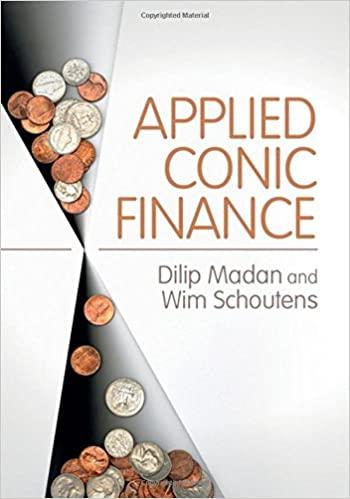Question
Below is a set of current (t = 0) prices on a set of zero-coupon bonds. The face value on all of these bonds is
Below is a set of current (t = 0) prices on a set of zero-coupon bonds. The face value on all of these bonds is $1000. The prices below are quoted per $1000 in face value. In answering the following questions, assume that you can buy fractions of a bond.
Bond Price
1-year zero 950
2-year zero 900
3-year zero 860
4-year zero 790
Also assume, for simplicity, that each of these bonds matures in exactly a multiple of a year from now (now = t = 0).You have $20,000 and want to make an investment that will allow you to have a down payment on a house in exactly two years.
Consider the following two alternative strategies:
1. You can invest in the default-free 3-year zero-coupon bond and sell it after two years(t = 2).
2. You can invest in the default-free 2-year zero-coupon bond.
Consider the first strategy (i.e., strategy 1) above.
A. If the forward rates implied by the bond price data above turns out to be the future rates that actually occur, what price (per $1000 in face value) will you get at t = 2 for the 3-year bonds you are buying at t = 0? That is, what is the price of these 3-year bonds in two years (at t = 2) from now (t = 0)? If the forward rates implied by the bond price data above turns out to be the future rates that actually occur, what will be your holding period yield on the 3-year bond you are buying at t = 0? That is, what is the internal rate of return on the first strategy (i.e., strategy a.)?
B. If the forward rates implied by the bond price data above turns out to be the future rates that actually occur, how much money will you have at t = 2 under this first strategy (i.e., strategy a.)?
C. If it turns out that the one-year yield at t = 2 is 1 percentage point higher than the forward rate implied by the bond price date now (at t = 0), how much money will you have at t = 0 to use as a down payment?
D. If it turns out that the one-year yield at t = 2 is 1 percentage point lower than the forward rate implied by the bond price date now (at t = 0), how much money will you have at t = 2 to use as a down payment?
Step by Step Solution
There are 3 Steps involved in it
Step: 1

Get Instant Access to Expert-Tailored Solutions
See step-by-step solutions with expert insights and AI powered tools for academic success
Step: 2

Step: 3

Ace Your Homework with AI
Get the answers you need in no time with our AI-driven, step-by-step assistance
Get Started


